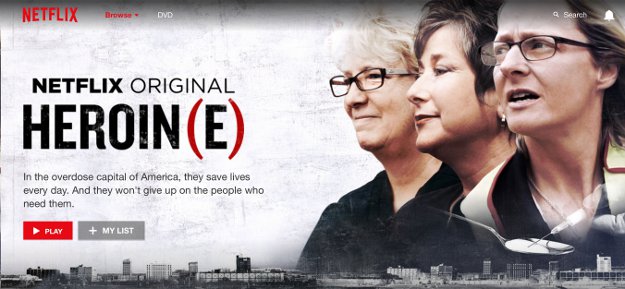‘Heroin(e)’ Depicts Life in ‘Overdose Capital of America’

Excerpt from BillMoyers.com. Read the rest of the article here.
Heroin(e) is a powerful [Netflix] film that follows the stories of three women in Huntington, West Virginia, who are battling the opioid crisis on its front lines. Drug addiction is so common in Huntington, the “overdose capital of America,” that it’s weaved into the fabric of everyday life. In one scene, paramedics work to revive an overdose victim at a convenience store while people step around the commotion and move along the checkout line as if nothing is happening.
Fire Chief Jan Rader is the first responder who carries not only the film, but also the weight of the crisis in her community as she works to save as many people as possible and get addicts into long-term recovery. Judge Patricia Keller is part mother-hen, part school principal, doling out encouragement and discipline with equal compassion. Necia Freeman, a volunteer with a local church group, drives around at night providing food, shelter and help to those teetering on the edge.
Opioid overdoses are now the leading cause of death for Americans under 50. Opioid overdoses are now the leading cause of death for Americans under 50, having killed 64,000 Americans in 2016, a 17 percent increase from the previous year. President Trump had promised to designate the crisis a “national emergency,” which would have prompted more federal dollars to help. Instead, he recently declared it a “public health emergency,” to the consternation of his critics.
I spoke with filmmaker Elaine McMillon Sheldon, who co-produced Heroin(e) with the Center for Investigative Reporting, and Chief Jan Rader about the growing epidemic, treatment options and making the film.
Titi Yu: Chief Rader, what did you think about the president’s announcement and how do you think it will affect your work as a first responder?
Jan Rader: Well, I guess we will see. In my mind it’s a good first step and I hope it’s backed up with more to come. Certainly opening up telemedicine in the rural communities is a help, because we do have a lack of providers. Bringing in [federal grant funds to target those with opioid addictions, part of Trump’s declaration] is going to help that, but it’s going to take further steps to deal with this epidemic.
TY: From your perspective, what does that look like? Is it more money?
JR: It’s such a complex issue. We’ll just take probably anything. But in our area, the No. 1 issue is that we have a bottleneck at detox. In Cabell County, with a population of 96,000 people, we only have eight detox beds. That’s important, because people have to go into detox before they go into recovery.
The other problem is that the eight detox beds we do have are not medically assisted, and we desperately need them to be. It’s almost inhumane because if they don’t die from detoxing off of opiates, they wish they were dead. So if we had medically assisted detox we’d have a lot more people willing to detox and get into long-term care.

Elaine McMillon Sheldon: And also Naloxone right, Jan?
JR: Oh yes, we use any and all Naloxone donations that we get. That’s where I would hope that Big Pharma would step up to the plate. You have to be alive in order to get into long-term care. Naloxone’s key to keeping people alive.
TY: So tell me more about Naloxone; what does it do?
JR: Opioids latch onto receptors in the brain that actually suppress the respiratory system. And if you stop breathing, or you’re not breathing sufficiently for five to six minutes, then you’re brain dead. Then the heart stops working. It’s critical to get to people as quickly as possible when they overdose. What Naloxone does is it knocks the opiate off those receptors so they start breathing again. That is key, and sometimes [people] wake up instantaneously.
TY: How expensive is Naloxone?
JR: You know, my department is quite poor. So for me to carry Narcan [the brand name for Naloxone], I have to accept donations. If we don’t have Narcan, we provide rescue breathing until Cabell County EMS arrives. For a nasal dose, you’re talking about $50 a dose. We had Evzio [a naloxone auto-injector], and those are [as much as $4,500] a box and there are two doses in the box.
The good thing about our area is that not only did our health department start applying grants so first responders can carry Naloxone, but they were also handing out free Naloxone to friends and families of those suffering from substance use disorder. Over 1,100 lives have been saved without intervention from first responders. For parents with an adult child that’s suffering from substance abuse disorder, they at least can sleep a little better at night knowing that they have a reversal drug to give to their own child if they overdose. So I think we need to continue to supply as much Naloxone to the general public as we possibly can.
TY: So Elaine, what prompted you to want to make this film?
EMS: You can’t live in West Virginia and not know that this problem has been impacting us for many years. Today, because of the headlines, everybody knows what’s going on here. But we’ve been experiencing this crisis since the ’90s, with the pill mill and then with heroin. I grew up in Logan, West Virginia, where right down the street a so-called doctor from another state set up shop in a cinder block building with no furniture, and had a woman just sitting there with a full bag of prescriptions, handing them out, day after day.
So this is part of growing up here. You knew it was happening. Once I got to high school and then college, it started taking classmates from me. We started seeing more people either dying or imprisoned for felonies such as robberies, to get drugs. Some of my friends have had their children taken away from them and put in the foster-care system. I didn’t want to speak about this subject for a long time because the majority of the media focuses on the bleak and dire circumstances of an addict. I don’t have it in me to put that kind of suffering on screen. I wanted to produce something that would hopefully guide us forward.
The film was a chance to not only highlight the women doing this work but also what the average citizen can do to help save a person’s life or to help make change.
Excerpt from BillMoyers.com. Read the rest of the article here.
Author Bio:
Titi Yu is a freelance documentary producer, director based in New York City. Yu has produced for PBS, HBO, NBC and other independent documentaries. Yu’s work focuses on social movements, human rights, and economic justice. Most recently, Yu reported from Standing Rock in 2016 and followed the development of Black Lives Matter during the 2016 election. Yu was a 2014 fellow at Columbia University’s Alliance for Historical Dialogue. She holds a B.A. from the University of Pennsylvania and M.A. from Emerson College.






























































































































































































































































































































